

|
| DEUTSCHLAND | GERMANY |
| Bundesland: Hessen | Hesse |
| Regierungsbezirk: Darmstadt | |
| Stadt: Frankfurt am Main |
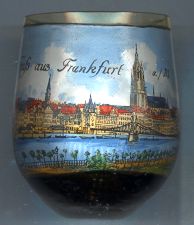 Frankfurt am Main is situated at an elevation of 112 m on the river Main southeast of the Taunus low mountain region
at the northern end of the Rhine Rift in southern Hesse. With a population of about 651,000 Frankfurt is the largest city
of Hesse and the fifth-largest city of Germany. The metropolitan region of Frankfurt has a population of about 1.8 million,
the region Frankfurt-Rhein-Main with its population of about 5 million is the second largest metropolitan region of Germany.
Frankfurt am Main is situated at an elevation of 112 m on the river Main southeast of the Taunus low mountain region
at the northern end of the Rhine Rift in southern Hesse. With a population of about 651,000 Frankfurt is the largest city
of Hesse and the fifth-largest city of Germany. The metropolitan region of Frankfurt has a population of about 1.8 million,
the region Frankfurt-Rhein-Main with its population of about 5 million is the second largest metropolitan region of Germany.
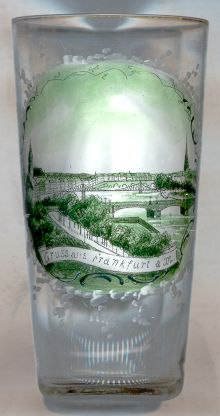 The oldest traces of regular settlements at this site date from the Neolithic period.
During the Roman period it was the site of a Roman military settlement and during the Merowinigian period it was the site
of a Frankish royal residence. The oldest document mentioning Franconofurd dates from AD 794.
In 843 the town became one of the most important residencies of the East Frankish kingdom and became the place of
Imperial diets. In 1220 Frankfurt obtained the status of a Free Imperial City. Since 1147 most of the elections of the
Roman (German) kings took place here. The Golden Bull of 1356 determined Frankfurt as the regular place of election.
From 1562 onward, Frankfurt also replaced Aachen as the site of coronation of the emperors of
the Holy Roman Empire. This tradition continued until the election and coronation in 1792 of the last Holy Roman Emperor,
Franz II (1804 Emperor Franz I of Austria).
The oldest traces of regular settlements at this site date from the Neolithic period.
During the Roman period it was the site of a Roman military settlement and during the Merowinigian period it was the site
of a Frankish royal residence. The oldest document mentioning Franconofurd dates from AD 794.
In 843 the town became one of the most important residencies of the East Frankish kingdom and became the place of
Imperial diets. In 1220 Frankfurt obtained the status of a Free Imperial City. Since 1147 most of the elections of the
Roman (German) kings took place here. The Golden Bull of 1356 determined Frankfurt as the regular place of election.
From 1562 onward, Frankfurt also replaced Aachen as the site of coronation of the emperors of
the Holy Roman Empire. This tradition continued until the election and coronation in 1792 of the last Holy Roman Emperor,
Franz II (1804 Emperor Franz I of Austria).
After the end of the Holy Roman Empire in 1806, Frankfurt came under the government of Karl Theodor von Dalberg, the last Prince Archbishop and Elector of Mainz, bishop of Konstanz, Worms and Regensburg. Dalberg's principality, which became a member of the Federation of the Rhine, included Frankfurt, Aschaffenburg and Regensburg. In 1810 Dalberg ceded Regensburg to Bavaria but received Hanau and Fulda as compensation. From 1810 until 1813 the remaining territory formed the shortlived Grand Duchy of Frankfurt. Dalberg abdicated in 1813 in favour of Napoleon's stepson Eugène Beauharnais. After the defeat of Napoleon and the Congress of Vienna (1815), Frankfurt was re-established as a Free City, Aschaffenburg came to Bavaria, Hanau and Fulda were given to the Electorate of Hesse (Hesse-Kassel), Wetzlar came to Prussia. Besides Hamburg, Bremen and Lübeck, Frankfurt was thus one of only four of the old free Imperial cities that could retain (or regain) their independence. From 1815 until 1866 Frankfurt was the seat of the 'Bundesversammlung', the supreme organ of the German Confederation (see map). The Frankfurt Parliament (Frankfurter Nationalversammlung) of 1848 was the first elected parliament for all Germany and drew up a constitution ('Paulskirchenverfassung'). During the German-Austrian war of 1866, the city officially sided with the German Confederation although the large parts of the general public sympathised with Austria. In July of that year the Prussia army occupied Frankfurt and in October the city was annexed by Prussia and was incorporated into the Prussian province Hesse-Nassau. It was also a symbol of reconsiliation, that Frankfurt, which thus had lost its independence was chosen in 1871 as the place of the treaty that officially ended the French-German war of 1871 (Treaty of Frankfurt).
The remaining decades of the 19th century were a period of strong industrial growth. For a short period at the beginning
of the 20th century, Frankfurt even was the largest German city by area. During the Nazi period, about 9,000 Jewish
inhabitants of the city were deported and most of the perished. During World War II, Frankfurt became a target of
Allied bombings. Until 1944 the historical city was unique in all Germany because it was a rare example of a metropolis
that had preserved its medieval appearance almost in its entirety. After the bomb raids (and the modern reconstructions of
the post-war era) almost nothing of the historical cityscape has remained. After the war, Frankfurt became the main seat
of the administration of the American occupation zone (see map). Frankfurt campaigned for
becoming the new capital of Germany, but in 1949 Bonn was eventually chosen. In the late 20th century the city became
one of the most important economic and financial centres of Germany. Since 1999 it is also the seat of the European
Central Bank.
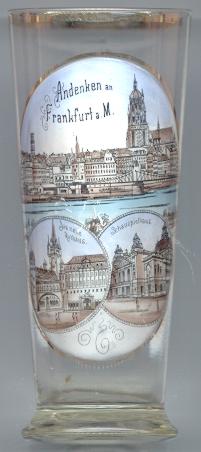
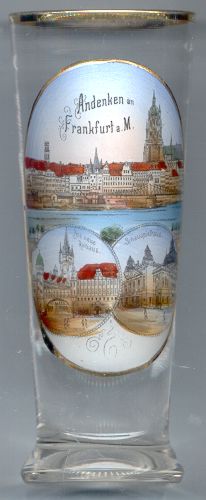
The  Kaiserdom Sankt Bartholomäus [left and right: top pictures]
is Frankfurt's largest church. Although it is popularly called 'Dom' (cathedral) it never was the seat of a bishop.
However, its importance as a national symbol is derived from its central role in the Holy Roman Empire.
From 1356 onwards, the kings of the Holy Roman Empire were elected in this church, and from 1562 to 1792, the emperors
were crowned here.
The present church is a three-naved hall church, characterised by a rather short nave (only 3 bays) and a
long transept from the 14th century. The monumental western tower dates from the 15th century.
During the early 18th century, much of the old Gothic interior decorations was remodeled in Baroque style.
After a large fire in 1866 the church was restored. During these works, the west tower was also completed based on
the original design of 1415, which in the 15th century had not been completed. In 1877 the tower was completed (now 95 m
tall) and the church was reopened in the following year. The bombings of 1943 and especially 1944, which destroyed allmost
the entire old town, also almost destroyed the cathedral. The church burnt out completely, only the tower survived.
The reconstruction of the church was begun in 1948 and lasted until 1953.
Kaiserdom Sankt Bartholomäus [left and right: top pictures]
is Frankfurt's largest church. Although it is popularly called 'Dom' (cathedral) it never was the seat of a bishop.
However, its importance as a national symbol is derived from its central role in the Holy Roman Empire.
From 1356 onwards, the kings of the Holy Roman Empire were elected in this church, and from 1562 to 1792, the emperors
were crowned here.
The present church is a three-naved hall church, characterised by a rather short nave (only 3 bays) and a
long transept from the 14th century. The monumental western tower dates from the 15th century.
During the early 18th century, much of the old Gothic interior decorations was remodeled in Baroque style.
After a large fire in 1866 the church was restored. During these works, the west tower was also completed based on
the original design of 1415, which in the 15th century had not been completed. In 1877 the tower was completed (now 95 m
tall) and the church was reopened in the following year. The bombings of 1943 and especially 1944, which destroyed allmost
the entire old town, also almost destroyed the cathedral. The church burnt out completely, only the tower survived.
The reconstruction of the church was begun in 1948 and lasted until 1953.
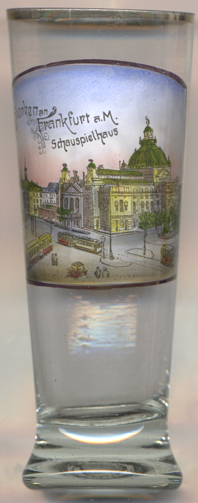
The  Schauspielhaus (municipal theatre) [far left, no. 982, and right,
no. 1477: both bottom right pictures, and near left, no. 3739]
was built in 1899–1902 by Heinrich Seeling and replaced the previous theatre that had been built in 1780–1782.
The theatre was destroyed in 1944. In its place, the new new Opera House was built after the war.
Schauspielhaus (municipal theatre) [far left, no. 982, and right,
no. 1477: both bottom right pictures, and near left, no. 3739]
was built in 1899–1902 by Heinrich Seeling and replaced the previous theatre that had been built in 1780–1782.
The theatre was destroyed in 1944. In its place, the new new Opera House was built after the war.
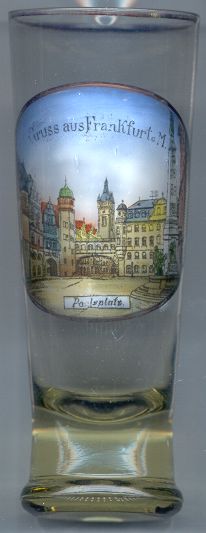
The bottom left pictures on the two glasses no. 982 and 1477 [above left and right] and the picture on glass no. 2077
[left] show the
The
The
Glass no. 1295 [left] shows a picture of the
The top picture on glass no. 1689 [right] shows the square
The
The
Glass no. 3868 [left] shows views of the Römer [top] and the Eschenheimer Tor
[bottom left], already described above.
The bottom centre picture shows the equestrian
The top right picture shows the
The
In July of 1909 the
The Palmengarten was established in 1868.
On 50 acers, the garden displays numerous plants throughout the year and offers a variety of recreational activities.
The
The  Paulsplatz
Paulsplatz Unity
Unity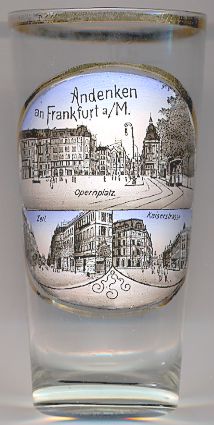
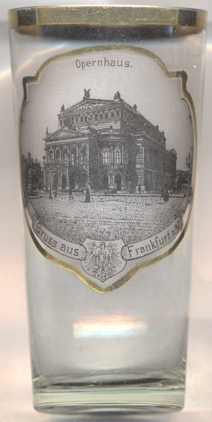 The top picture on glass no. 2362 [near left] show the
The top picture on glass no. 2362 [near left] show the  Opernplatz
Opernplatz opera house
opera house Zeil [bottom left] (literally 'row') is certainly one of the best-known streets of Frankfurt.
When in 1333 the Neustadt ('New Town') of Frankfurt was founded outside the medieval town wall, a row of houses was built parallel to the
old fortifications, leaving a broad strip between the building and the old town moat. In the 16th century the moat was filled in and the plot
was covered with new buildings. This is why the Zeil always remained one of the broadest streets of Frankfurt.
In 1730 the Baroque main guards building (Hauptwache) was built at the western end of the Zeil. The other end was marked by the building of the
Konstabler guards (Konstablerwache), but that building was pulled down already in 1822. During the late 18th and early 19th century
many buildings that lined the Zeil were rebuilt in Classicist style. After 1871, during the building boom of the 'Gründerzeit',
many department stores replaced the old residential palaces. During a bomb raid on 22 March, 1944, the Zeil was almost completely
destroyed. After the war, the street was rebuilt in a typically post-war, simple modern style. Today, the Zeil is one of the busiest
shopping streets of Germany.
Zeil [bottom left] (literally 'row') is certainly one of the best-known streets of Frankfurt.
When in 1333 the Neustadt ('New Town') of Frankfurt was founded outside the medieval town wall, a row of houses was built parallel to the
old fortifications, leaving a broad strip between the building and the old town moat. In the 16th century the moat was filled in and the plot
was covered with new buildings. This is why the Zeil always remained one of the broadest streets of Frankfurt.
In 1730 the Baroque main guards building (Hauptwache) was built at the western end of the Zeil. The other end was marked by the building of the
Konstabler guards (Konstablerwache), but that building was pulled down already in 1822. During the late 18th and early 19th century
many buildings that lined the Zeil were rebuilt in Classicist style. After 1871, during the building boom of the 'Gründerzeit',
many department stores replaced the old residential palaces. During a bomb raid on 22 March, 1944, the Zeil was almost completely
destroyed. After the war, the street was rebuilt in a typically post-war, simple modern style. Today, the Zeil is one of the busiest
shopping streets of Germany.
 Kaiserstraße [bottom right]
connects the inner city with Frankfurt central railway station. The section between Rossmarkt and Taunusanlage (Taunus park)
was laid out in 1874. At the time it connected the inner city with three railway stations that were located at the Taunusanlage,
i.e. the terminus stations of the Taunus Railroad, the Main-Neckar Railroad and the Main-Weser Railroad. In 1888 these stations were replaced
by the new central station which was located about 1 km further west. The area that prior to that had been occupied by
tracks and other railway grounds, now was transformed into a new city quarter (Bahnhofsviertel) with the outer section of
Kaiserstraße as its main street. Between 1947 and 1955 the street was named Friedrich-Ebert-Straße for F. Ebert,
the first president of the Weimar Republic. Despite the destructions during World War II and the many demolitions that
occurred in Frankfurt during the 1960's, the Kaiserstraße is one of only few streets of Frankfurt that could retain most of
its original buildings from the late 19th century.
Kaiserstraße [bottom right]
connects the inner city with Frankfurt central railway station. The section between Rossmarkt and Taunusanlage (Taunus park)
was laid out in 1874. At the time it connected the inner city with three railway stations that were located at the Taunusanlage,
i.e. the terminus stations of the Taunus Railroad, the Main-Neckar Railroad and the Main-Weser Railroad. In 1888 these stations were replaced
by the new central station which was located about 1 km further west. The area that prior to that had been occupied by
tracks and other railway grounds, now was transformed into a new city quarter (Bahnhofsviertel) with the outer section of
Kaiserstraße as its main street. Between 1947 and 1955 the street was named Friedrich-Ebert-Straße for F. Ebert,
the first president of the Weimar Republic. Despite the destructions during World War II and the many demolitions that
occurred in Frankfurt during the 1960's, the Kaiserstraße is one of only few streets of Frankfurt that could retain most of
its original buildings from the late 19th century.
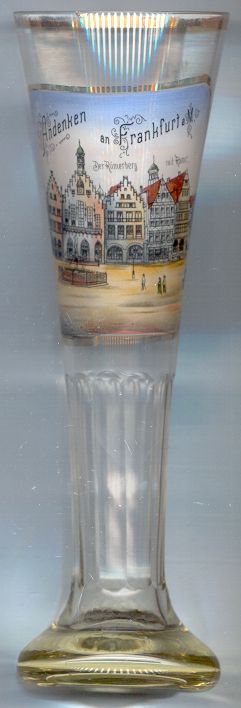
 Römerberg
Römerberg Römer
Römer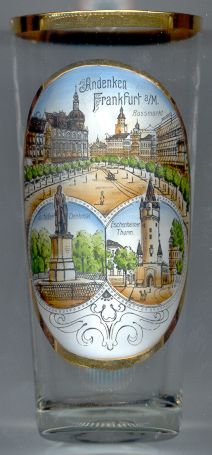
 Rossmarkt
Rossmarkt monument for Johann Wolfgang von Goethe [right, no. 1689: bottom left picture]
is located in the central part of Rossmarkt, which since 1844 is called Goetheplatz.
The monument was created in 1840 by Ludwig Schwanthaler. The monument was set up here in 1844.
monument for Johann Wolfgang von Goethe [right, no. 1689: bottom left picture]
is located in the central part of Rossmarkt, which since 1844 is called Goetheplatz.
The monument was created in 1840 by Ludwig Schwanthaler. The monument was set up here in 1844.
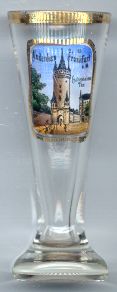
 Eschenheimer Tor (Eschenheim Gate) [near left, no. 1132, and right, no. 1689: bottom right picture]
is located a short distance away north of the square Hauptwache. The square was created in 1810 when the fortifications
of 1333 and the Baroque bastions were pulled down. The gate tower (Eschenheimer Turm, 47 m tall) was preserved as
the most representative of the former gate towers. The tower was built in 1400–1428.
Eschenheimer Tor (Eschenheim Gate) [near left, no. 1132, and right, no. 1689: bottom right picture]
is located a short distance away north of the square Hauptwache. The square was created in 1810 when the fortifications
of 1333 and the Baroque bastions were pulled down. The gate tower (Eschenheimer Turm, 47 m tall) was preserved as
the most representative of the former gate towers. The tower was built in 1400–1428.
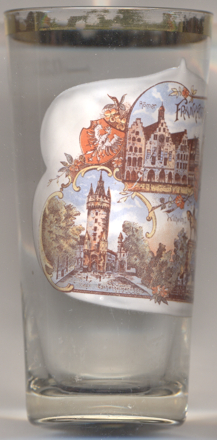
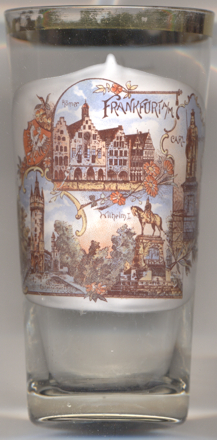
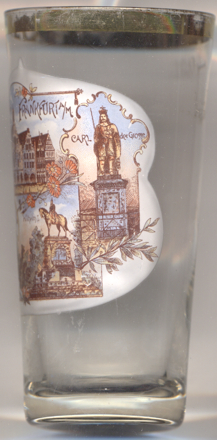
 monument
monument
[Liste der Kaiser-Wilhelm-I.-Denkmäler]
 monument
monument
[https://www.op-online.de/region/frankfurt/statue-karl-grossen-ziert-alte-bruecke-frankfurt-6802596.html]
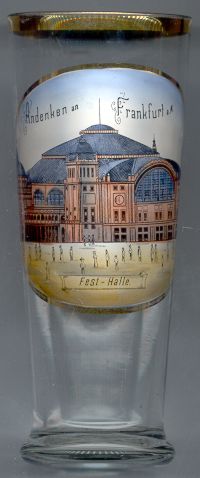
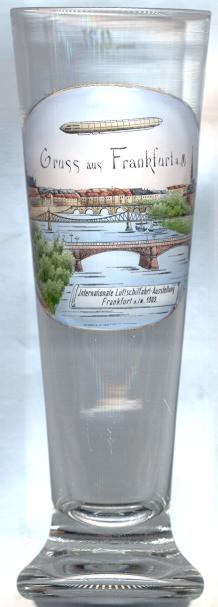
 Festhalle [lef, no. 1704]
was built in 1908–1909 by Friedrich von Thiersch. At the time of its construction, the building included Europe's
largest cupola (total height: 40 m). The building had an interior length of 90 meters and an interior width of 60 metres.
The Festhalle was officially opened by German Emperor Wilhelm II on 19 May 1909.
Festhalle [lef, no. 1704]
was built in 1908–1909 by Friedrich von Thiersch. At the time of its construction, the building included Europe's
largest cupola (total height: 40 m). The building had an interior length of 90 meters and an interior width of 60 metres.
The Festhalle was officially opened by German Emperor Wilhelm II on 19 May 1909.
 International
International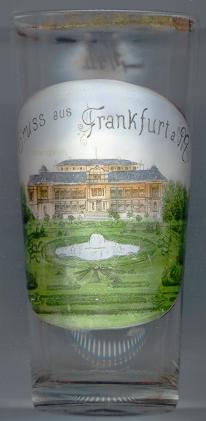
 Gesellschaftshaus
Gesellschaftshaus
Höchst am Main
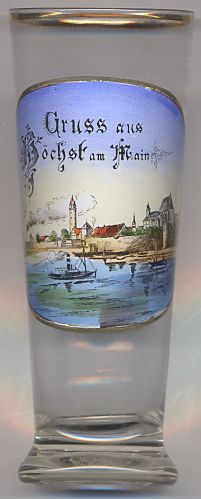 Höchst is first mentioned in AD 790 as Hostat (meaning high site or high place).
In 1355 Höchst received its town privileges by Emperor Karl IV. In the following year, the emperor granted
additional privileges including the right to hold weekly markets. Despite its city status, Höchst remained under the#
administration by the archbishops of Mainz. Situated at the eastern border of the ecclesiastical
state, Höchst was a border town with customs facilities. During the 18th century, Höchst became a flourishing trading place.
The Reichsdeputationshauptschluss of 1802 and the following secularisation brought an end to the ecclesiastical state of
Mainz. Höchst became part of the Principality of Nassau-Usingen, which soon after merged into the Duchy of Nassau.
In 1821 a reform of the dioceses followed, detaching Höchst from the diocese of Mainz and placing it in the newly established
diocese of Limburg. The industrial revolution of the 19th century was to shape Höchst again.
The "Theerfarbenfabrik Meister, Lucius & Co." was founded in 1863. Under the name "Farbwerke Höchst" and later
"Hoechst AG" it became one of Germany's leading chemical companies. After the Prussian-Austrian War of 1866, Höchst together
with Nassau became part of Prussia. After World War I and the Treaty of Paris (Versailles),
Höchst was occupied by France and remained under French supervision until 1929. In 1928, Höchst am Main was incorporated
into Frankfurt am Main.
Höchst is first mentioned in AD 790 as Hostat (meaning high site or high place).
In 1355 Höchst received its town privileges by Emperor Karl IV. In the following year, the emperor granted
additional privileges including the right to hold weekly markets. Despite its city status, Höchst remained under the#
administration by the archbishops of Mainz. Situated at the eastern border of the ecclesiastical
state, Höchst was a border town with customs facilities. During the 18th century, Höchst became a flourishing trading place.
The Reichsdeputationshauptschluss of 1802 and the following secularisation brought an end to the ecclesiastical state of
Mainz. Höchst became part of the Principality of Nassau-Usingen, which soon after merged into the Duchy of Nassau.
In 1821 a reform of the dioceses followed, detaching Höchst from the diocese of Mainz and placing it in the newly established
diocese of Limburg. The industrial revolution of the 19th century was to shape Höchst again.
The "Theerfarbenfabrik Meister, Lucius & Co." was founded in 1863. Under the name "Farbwerke Höchst" and later
"Hoechst AG" it became one of Germany's leading chemical companies. After the Prussian-Austrian War of 1866, Höchst together
with Nassau became part of Prussia. After World War I and the Treaty of Paris (Versailles),
Höchst was occupied by France and remained under French supervision until 1929. In 1928, Höchst am Main was incorporated
into Frankfurt am Main.
[Text in part adapted from http://en.wikipedia.org/wiki/Höchst_(Frankfurt_am_Main)]
 Höchst castle [left] goes back to a stronghold and toll station of the 14th century.
The tall keep is the only remnant of this structure from the Gothic period. In 1568 the castle was converted into a
Renaissance residential castle of the archbishops of Mainz. Large parts of this castle were destroyed during the
Thirty Years' War in 1635. In 1681 the keep received its characteristic Baroque domed roof.
In 1772–1774, the brickls of the ruins of the Renaissance castle were used for the construction of the Bolongaro Palace
in Höchst Neustadt and only the vaults of the old castle remain today. A new wing was added to Höchst castle in the
19th century. After World War II it was used by the US radio station AFN; later, it was acquired by Hoechst AG.
After the fusion of the company with Rhone-Poulenc and the relocation of the corporation's principal offices to
Stasbourg, the castle was purchased by the German Foundation for the Protection of Historical
Monuments (Deutsche Stiftung Denkmalschutz).
Höchst castle [left] goes back to a stronghold and toll station of the 14th century.
The tall keep is the only remnant of this structure from the Gothic period. In 1568 the castle was converted into a
Renaissance residential castle of the archbishops of Mainz. Large parts of this castle were destroyed during the
Thirty Years' War in 1635. In 1681 the keep received its characteristic Baroque domed roof.
In 1772–1774, the brickls of the ruins of the Renaissance castle were used for the construction of the Bolongaro Palace
in Höchst Neustadt and only the vaults of the old castle remain today. A new wing was added to Höchst castle in the
19th century. After World War II it was used by the US radio station AFN; later, it was acquired by Hoechst AG.
After the fusion of the company with Rhone-Poulenc and the relocation of the corporation's principal offices to
Stasbourg, the castle was purchased by the German Foundation for the Protection of Historical
Monuments (Deutsche Stiftung Denkmalschutz).
 Justinuskirche (church of St. Justin) [right]
is the oldest preserved historical building of Frankfurt. The three-naved basilica dates from aournd AD 830.
The choir in Late Gothic style was added after 1441. The church in one of only few examples of early medieval churches
that have remained in Germany.
Justinuskirche (church of St. Justin) [right]
is the oldest preserved historical building of Frankfurt. The three-naved basilica dates from aournd AD 830.
The choir in Late Gothic style was added after 1441. The church in one of only few examples of early medieval churches
that have remained in Germany.
![[scale]](lineal.jpg)